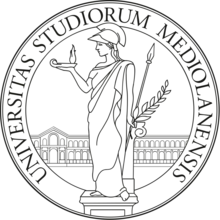The University of Milan (Italian: Università degli Studi di Milano, Latin: Universitas Studiorum Mediolanensis), known colloquially as UniMi or Statale, is a higher education institution in Milan, Italy. It is one of the largest universities in Europe, with about 60,000 students,[5] and a permanent teaching and research staff of about 2,000.[6]
The University of Milan has ten schools and offers 140 undergraduate and graduate degree programmes, 32 Doctoral Schools and 65+ Specialization Schools. The University's research and teaching activities have grown over the years and have received important international recognitions.
The University is the only Italian member of the League of European Research Universities (LERU), a group of twenty-one research-intensive European Universities. It consistently ranks one of the best universities of Italy, both overall and in specific subject areas.
One Nobel laureate in physics, Riccardo Giacconi,[7] as well as one Fields medalist, Enrico Bombieri,[8] studied at the University.
History
The University of Milan was founded in 1924 from the merger of two institutions that boasted a great tradition of medical, scientific and humanistic studies: the Accademia Scientifico-Letteraria (Scientific-Literary Academy), active since 1861, and the Istituti Clinici di Perfezionamento (Clinical Specialisation Institutes), established in 1906. By 1928, the University already had the fourth-highest number of enrolled students in Italy, after the University of Naples, Sapienza University of Rome and the University of Padua. Its premises are located in Città Studi (the City of Studies), the university district built from 1915 onwards (that is also home to the Politecnico di Milano), where scientific schools have its headquarters, and in several buildings in the historic city centre, which house the humanities schools.[22]
At the time of its foundation, there were four "traditional" schools – Law, Humanities, Medicine and Mathematical, Physical and Natural Sciences; then, in the 1930s, the Schools of Veterinary Medicine and Agriculture were introduced, after the aggregation of the old schools of Veterinary Medicine (1792) and Agriculture (1871).
At the end of the Second World War, the old Ospedale dei Poveri (Hospital for the Poor) building, known as "la Cà Granda" (the Big House), was assigned to the University. The building, one of the first Italian examples of civil architecture – commissioned in the 15th century by the Sforza family, the dukes of Milan – was seriously damaged by the bombings of 1943. In 1958, after a complex series of reconstruction and renovation works, it became home to the University Rector's Office, the administrative offices and the schools of Law and Humanities.
Rankings
The University of Milan is the only Italian member of the League of European Research Universities (LERU), a group of twenty-one research-intensive European Universities, which it helped found.[15][16]
The university consistently ranks as Italy's best university in a number of areas. In the most recent ranking of Italian universities released by ANVUR in February 2017, Statale ranked first among Italian universities in the areas of political science, sociology, law, and philosophy.[17] It also ranked among the top three in economics and statistics, earth science, history, and antiquities.[18]
The university is ranked third in Italy by Center for World University Rankings (CWUR)[19] and fourth in the Webometrics Ranking of World Universities.[20] It is ranked first in Italy (five-way tie) by the Academic Ranking of World Universities while the Times Higher Education World University Rankings[21] ranks it 6th to 9th (tied with four other universities).
Contact Information
unimi@postecert.it
Contact Email
Contact Phone
Location
Via Festa del Perdono, 7, 20122 Milano MI
Milan , Italy



